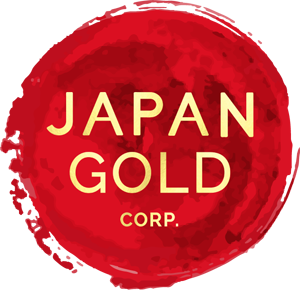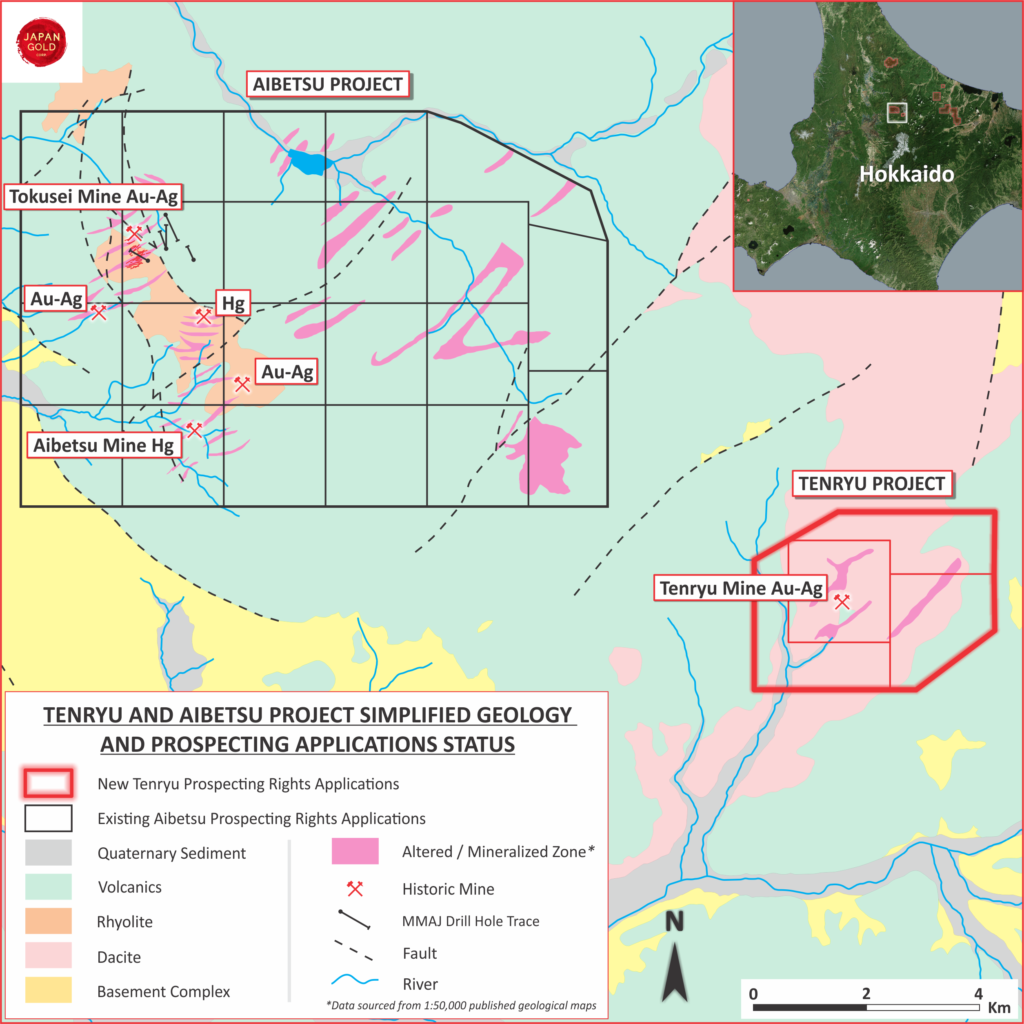The Aibetsu Project
Highlights
- Five historic epithermal gold / silver and mercury mines are located within the Aibetsu Project area and includes the Tokusei mine, which produced 38,580 ounces of gold and 472,620 ounces of silver between 1930-1942¹.
- The project area has had only limited exploration since the 1940’s which included mapping, soil sampling, and resistivity surveys by the Metal Mining Agency Japan (MMAJ) over the Tokusei mine area between 1998-2002. Soil and mapping data showed the vein system may have potential plunge extensions that are untested along strike to the northeast and southwest.
- This work culminated in five diamond drill holes up to 700 m deep for a total of 3,400 m targeted mainly on Tokusei mine extensions.
- The best results came from drill hole 13MAHB-2 of 0.95 m @ 69 g/t Au and 263 g/t Ag from a quartz vein intersected approximately 340 m below surface
- The Company’s 2017 exploration program confirmed the presence of high-grade gold mineralization within and around the historic Tokusei mine workings and emphasized significant potential for extensions to the epithermal vein system at the Tokusei mine.
- Drilling is warranted at the Tokusei and Motoyama prospects as well as low-impact exploration activities across the eastern part of the Aibetsu project.
History
The Aibetsu Project area contains the Tokusei mine, which produced 38,580 ounces of gold and 472,620 ounces of silver, mined from quartz-adularia veins between 1930-1942¹. No information or production statistics are available on historical exploration and development work conducted in the other mine areas located in the Aibetsu Project area pre-WWII.
The project area has had only limited exploration since the 1940’s. As part of a regional metallogenic study, the MMAJ undertook regional surveys (geophysical and drainage sediment sampling) and later prospect evaluation work (2000-02) over the Tokusei mine area. A total of 730 grid-based soil and rock samples were collected and analyzed, along with 29.0-line km of ground IP-resistivity surveying reported by the MMAJ2.
Coincident resistivity highs and Au-As-Hg soil anomalies were identified to the south-southwest and northeast of the Tokusei mine workings. Five diamond drill-holes (3,400 m) targeted these anomalies, and extensions to the Tokusei vein system. Significant mineralized intercepts from holes drilled beneath a Au-As-Hg soil anomaly located approximately 500 m northeast of the Tokusei mine workings include 0.95 m @ 69 g/t Au, 263 g/t Ag (13MAHB-1) and 0.16 m @ 11.8 g/t gold and 7 g/t Ag (13MAHB-2), in two separate drill-holes. An gold intercept of 1.0 m @ 1.92 g/t gold and 11 g/t silver from within a 7.5 m stockwork zone was recorded from drill hole 14MAHB-1, located approximately 500 m to the southeast of drill hole 14MAHB-1, along a parallel structure (true widths were not reported or are unavailable)
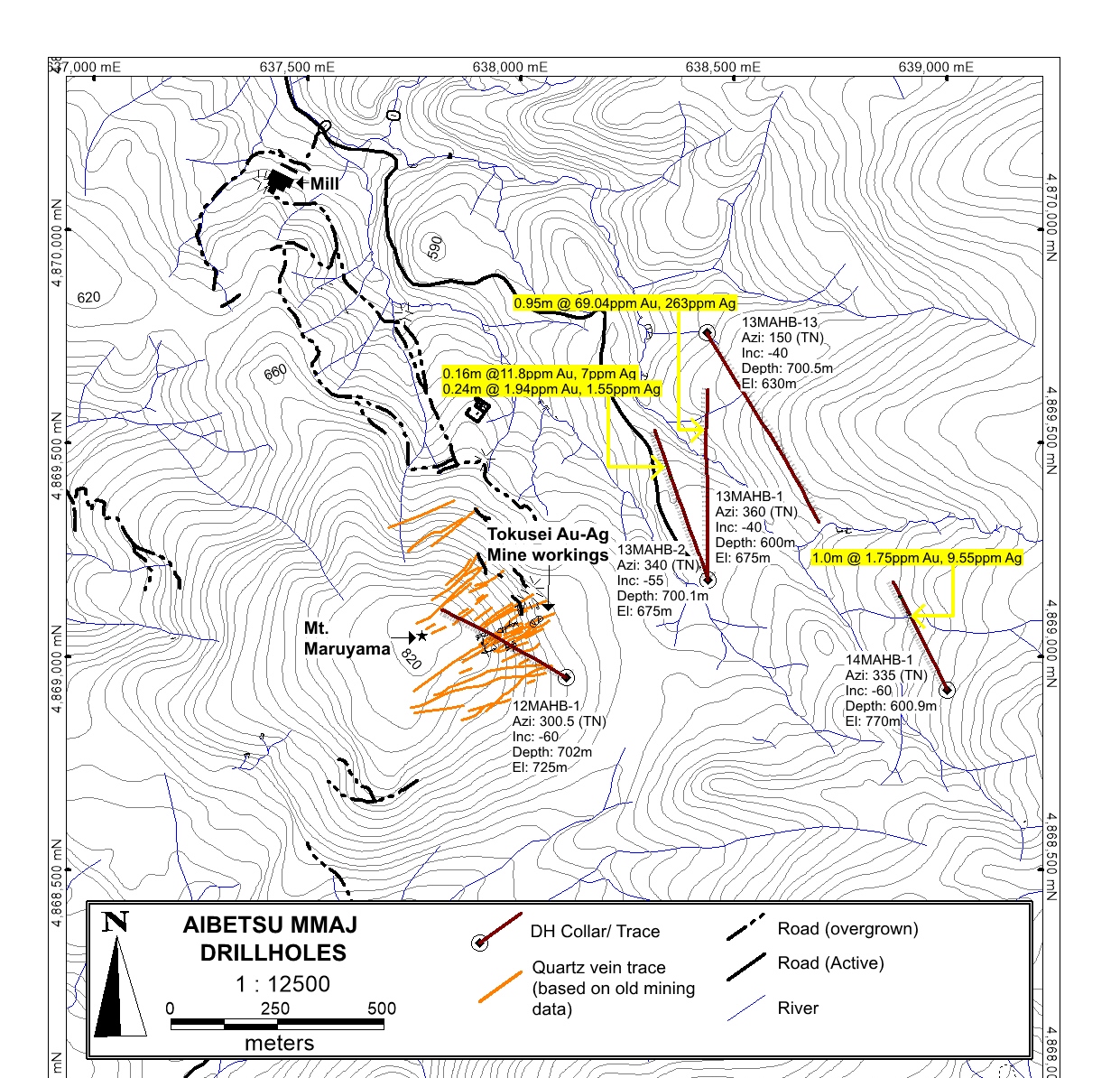 MMAJ diamond drill hole location and significant assays in and around the Tokusei mine area, Aibetsu Project.
MMAJ diamond drill hole location and significant assays in and around the Tokusei mine area, Aibetsu Project.
Geology and Mineralisation
The gold mineralization style at Aibetsu is classified as rift-related, low-sulfidation epithermal. Mineralization is typically associated with quartz-chalcedony-adularia-sericite±calcite fill in silicified and veined- or brecciated-structures, including dark sulfidic material, termed ginguro bands. Veins display crustiform-colloform banding, cockade, lattice blades (quartz pseudomorphs after calcite, indicative of fluid boiling zones) and other quartz textures typical of high-level epithermal systems. Wall-rock alteration comprises a silicified core and peripheral mixed quartz-illite-smectite (argillic) assemblages. Mineralization at the Tokusei mine is associated with an easterly- to northeasterly-trending tensional quartz vein swarm, the most notable of which is the Sanjin-Hi vein with and average width of 6.4 m (true width) and an average gold grade of 17.7 g/t gold3. Banded chalcedonic quartz veins consistently host the highest tenor of precious metal mineralisation in the Tokusei mine area. Massive quartz +sulphide veins around the Motoyama mercury mine contain a relatively lower tenor of gold-silver mineralisation, however, are highly anomalous in As-Sb-Hg-Tl, suggesting they might have formed at a higher paleo-level above a Tokusei-style vein system.
Exporation
Japan Gold executed geological mapping, geochemical rock sampling, and soil sampling activities across the western half of the Aibetsu Project in 2017. Detailed mapping has allowed the preparation of interpretive geology and alteration maps of the western portion of the tenement. Gold-bearing veins were also located, described and sampled. A total of 237 rock samples were collected. The soil sampling program covered the areas of highest priority, the Tokusei mine area and the Motoyama and Yamamezawa mercury mine areas to the south. Soil sample locations were designed to supplement the available soil data from previous MMAJ activities. A total of 581 soil samples were analysed for gold, silver and a multi-element ICP suit. Soil samples were collected at 50 m intervals along 500 m spaced north-south grid-lines. At the Tokusei mine area these lines infilled previous MMAJ soil lines giving a overall 250 m spaced line separation.
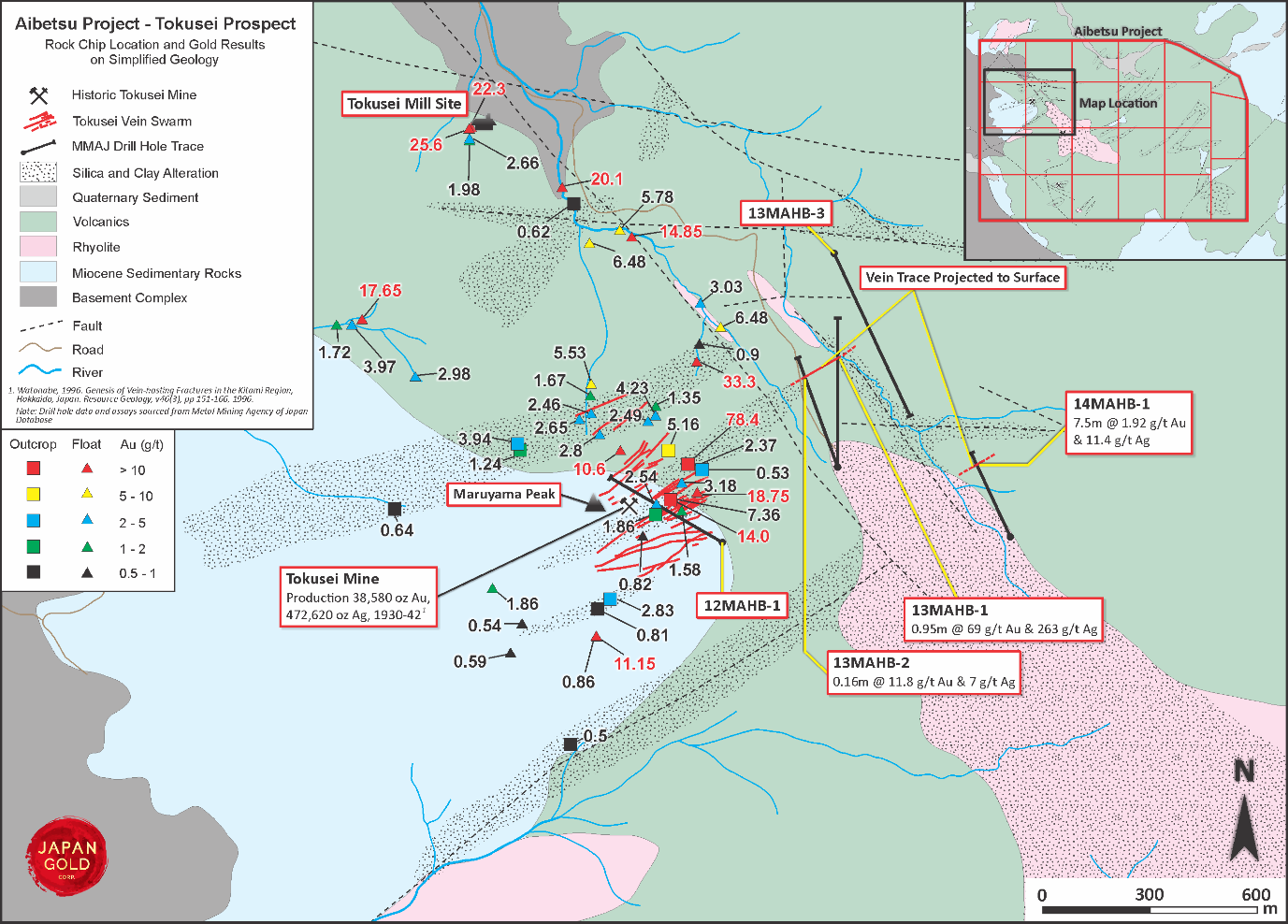 Gold in rock results from the Tokusei Au-Ag and Yamamezawa Hg mine areas.
Gold in rock results from the Tokusei Au-Ag and Yamamezawa Hg mine areas.
Exploration results confirmed the presence of high-grade gold mineralization within and around the historic Tokusei mine workings and emphasize significant potential for extensions to the epithermal vein system at the Tokusei mine.
Exploration results to date indicate that gold and silver are concentrated in banded chalcedonic quartz veins, with assays ranging from 0.01 - 78.4 g/t Au and 0.05 - 380 g/t Ag, and that selenium has a strong correlation to gold-silver in rock samples. Other pathfinder elements in rock- and soil-samples include As, Sb, Tl, Hg and W. The optimal depth range for the veins discovered to date ranges from the 580 m RL to surface (up to 820 m RL), representing a 240 m vertical extent. The productive veins in the Tokusei mine area strike easterly to northeasterly, dip steeply and are localized near the contact between Miocene sedimentary rocks and underlying andesitic volcanic rocks. The vein system is open to the southwest. Soil and rock geochemical anomalies indicate that the Motoyama mercury mine area is prospective for gold-silver.
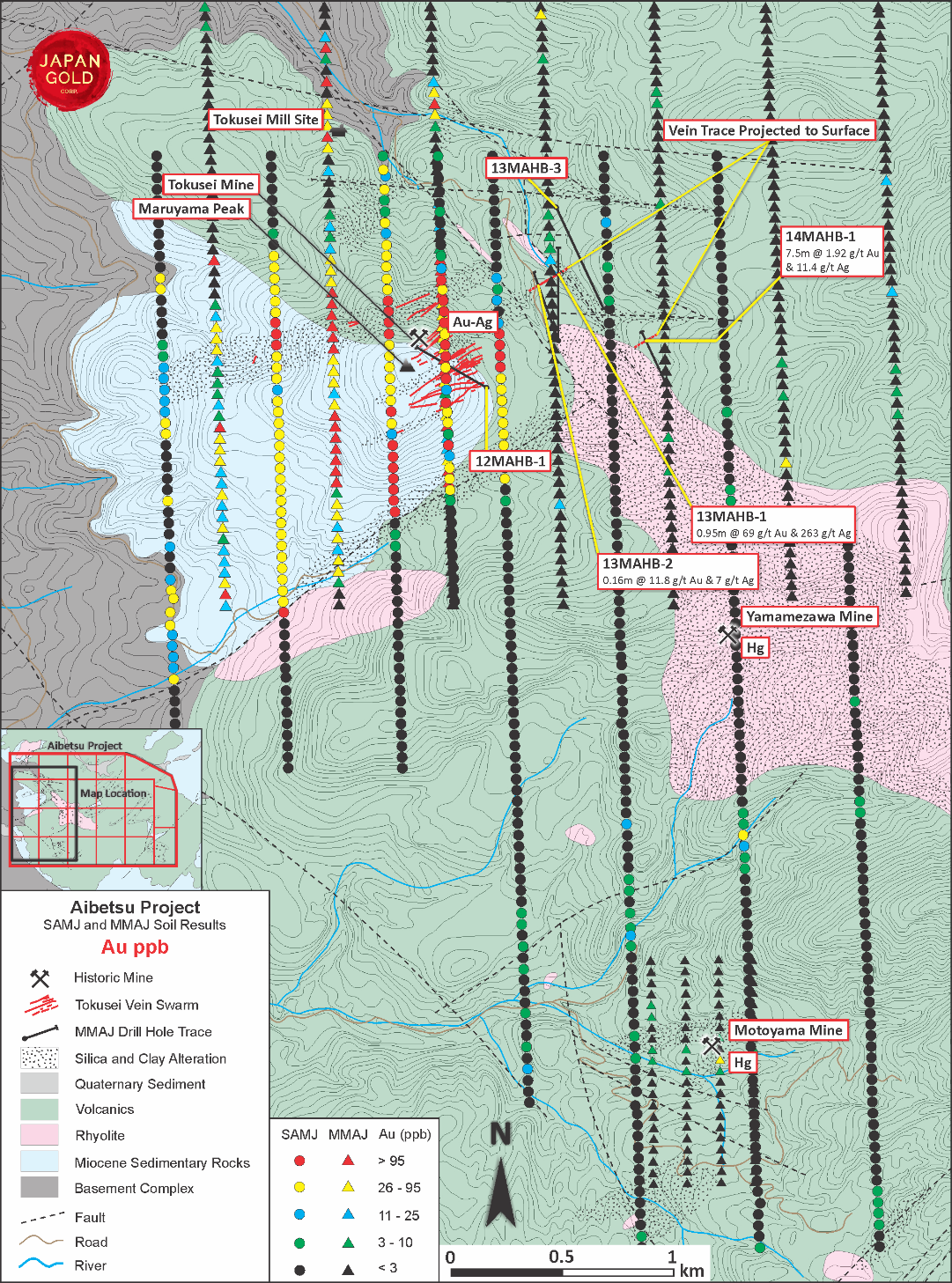 Gold in soil results across the western half of the Aibetsu project area.
Gold in soil results across the western half of the Aibetsu project area.
Mapping conducted along grid lines has confirmed the presence of silica capping and sinter outcrops on Mt Maruyama above the Tokusei veins, suggesting limited erosion has occurred, the vein systems are likely well preserved, and thus, the full down-dip extent of the vein systems could be intact or preserved.
Complete results from the 2017 exploration program at Aibetsu can be found in the Company’s news release dated: February 28, 2018.
No recent field work has been completed across the eastern half of the Aibetsu Project area. Available stream sediment data indicates possible gold mineralization in the southeastern portion of the Aibetsu Project, which remains unexplored, Japan Gold intends to complete regional exploration coverage of this part.
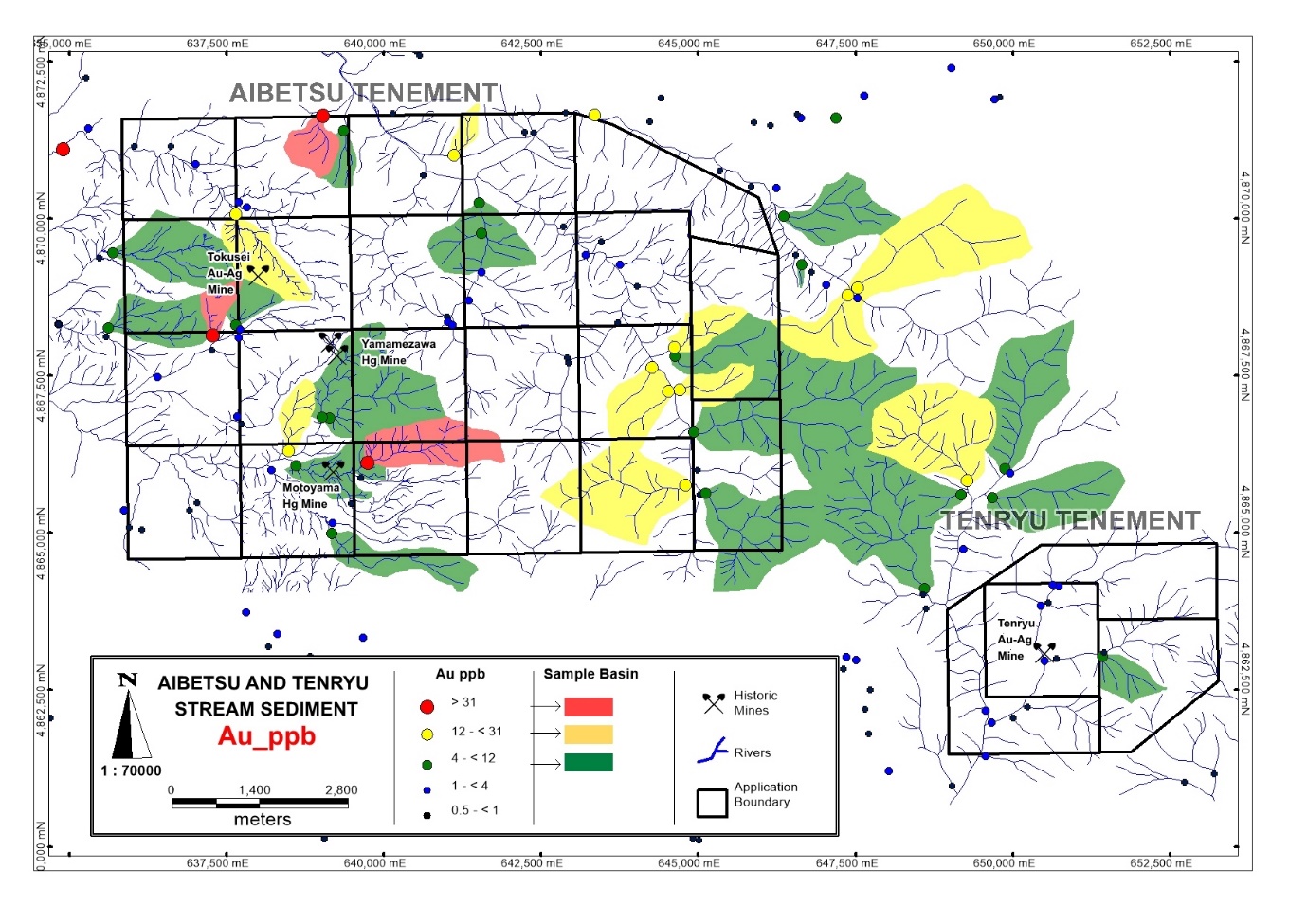 Gold (ppb) in stream sediment results from the MMAJ drainage sampling program.
Gold (ppb) in stream sediment results from the MMAJ drainage sampling program.
Exploration Potential
Drilling is warranted at the Tokusei and Motoyama prospects. Diamond drill-holes are proposed to test the southwestern extensions of the vein system at Tokusei, proximal to the Miocene sedimentary – volcanic lithological contact.
The down-dip extension of the upper, mercury-bearing portions of the Motoyama vein system is also recommended for drill testing. Holes are proposed to target a possible intact gold-silver zone at depth.
Low-impact exploration activities are recommended across the eastern part of the Aibetsu Project. Available stream sediment data indicate possible gold mineralization in the southeastern portion of Aibetsu.
References
1 Watanabe, 1996. Genesis of Vein-hosting Fractures in the Kitami Region, Hokkaido, Japan. Resource Geology, v46(3), pp 151-166, 1996.
2 The Mining & Materials Processing Institute of Japan (MMAJ), 1990. Gold Mines of Japan, Volume 2: Hokkaido.

